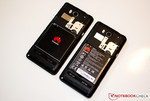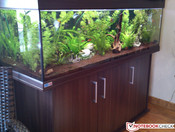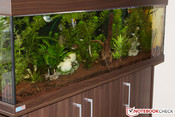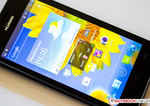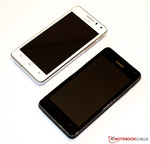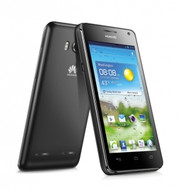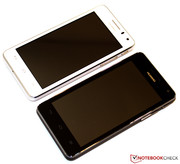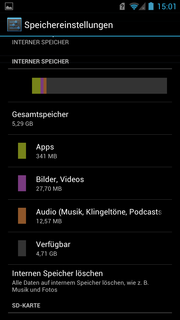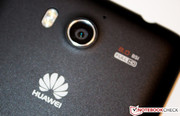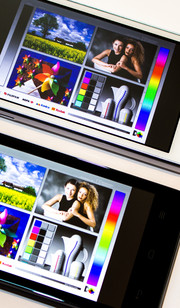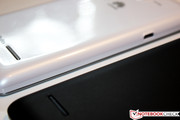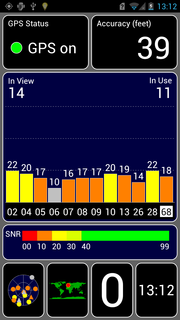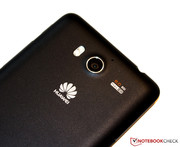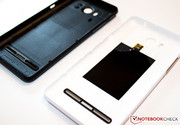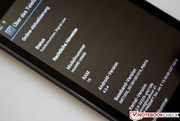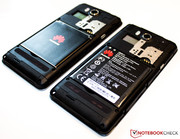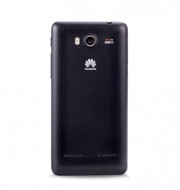Review Huawei Ascend G615 Smartphone
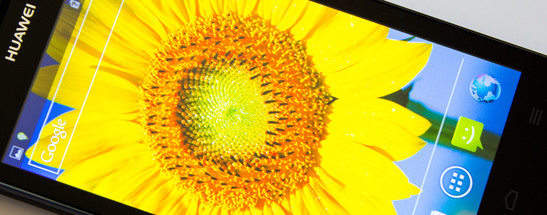
For the original German review, see here.
We reviewed the Huawei Ascend G600 quite recently. The smartphone did reasonably well, although we had issues with the performance in some areas. It seemed that the phone was operating at its limit most of the time as we noticed micro-stutters in the app drawer and on the home screen. The display performance was adequate - but not really comparable to the Ascend D1 Quad XL. Overall, the G600 was not a bad deal at the MSRP of 299 Euro (~$390) - at least not until the introduction of its successor, the Huawei Ascend G615.
The G615 combines the looks of the G600 with the performance of the D1 Quad XL. Huawei uses their own HiSilicon Quad-Core K3V2 with a core frequency of 1.4 GHz and a 16-core GPU. The phone comes equipped with 1024 MB RAM and 8 GB of internal storage, which can be expanded using a MicroSD card. The 4.5-inch display uses IPS technology and features a resolution of 1280 x 720 pixels. The hardware is more or less identical to the D1 Quad XL. Unfortunately, Huawei does not use the latest version of the Google operating system - the G615 uses Android version 4.0.4 instead. At this point it is unclear when (and if) an update will be provided.
In the following review, we will determine if the new phone manages to eliminate the shortcomings of the G600 and how the hardware of the D1 Quad XL performs in the newer design.
Case
The design is almost completely identical to the G600. Only very close examination reveals that the predecessor is slightly thicker. Our measurements show that the G615 is 0.5 millimeter thinner and 0.5 millimeter wider - the volume of the unit remains unchanged. The phone measures a fairly large 134 mm x 67.5 mm x 10.5 millimeters (5.28 x 2.66 x 0.41 inches) and weighs in at 145 grams (5.11 ounces) - exactly the same weight as the G600 and the D1 Quad XL.
The back cover is still made from polycarbonate - although this time around, it's matte and textured instead of being glossy. This not only improves the visual appearance - the G615 does look more upscale - but also improves ergonomics, as the phone is easier to hold. The build quality also appears similar: the phone is rigid and resists twisting well. Huawei offers the new smartphone in both white and black.
Connectivity
The location of the physical buttons, the speaker, and the camera module remain unchanged - only the opening for the microphone has been moved by a few millimeters. Removing the back cover reveals the SIM card and the slot for the MicroSD card in identical positions. The replaceable battery of the G615, which offers 220 mAh (+ 1.07 Wh) more capacity, fits into the G600 and the phone can be used with it even though the voltage differs by 0.1 volts.
Software
Most Huawei smartphones ship with the same OS: Android 4.0.4. At the time of writing, we do not know when Huawei will offer an update to a newer version of the Google operating system.
Communication & GPS
The G615 uses the WLAN module also found in the D1 Quad XL and the G600. It supports standards 802.11 b/g/n and works flawlessly without dropping connections. The GPS module also maintains connections reliably. We did notice a difference when we checked downloads speeds when using mobile Internet: the G600 was limited to 7.2 Mbit/s; the G615 reached up to 21 Mbit/s. Both smartphones come with Bluetooth 3.0 and DLNA. The G615 is missing a NFC module, however - which seems to confirm that Huawei is using the same hardware also found in the D1 Quad XL.
Cameras & Multimedia
The G615's main camera features a resolution of 8 MP and uses a dual LED flash system. The camera up front only has a 1.3 megapixels lens - but at least that is 1 MP more than the camera found in the G600. Both cameras use the same sensors as the ones found in the D1 Quad XL and produce similar results.
The main camera resolves a lot of detail and produces vivid colors. We noticed noise only when taking pictures in dark areas, although it was always quite a bit less than what we experienced with the G600. What's true inside is also true outside: the sensor produces brighter results and colors that are more life-like.
Accessories
No surprises here. In addition to various pamphlets, the manufacturer includes a modular power supply and a headset (not an in-ear design).
Warranty
In Germany, the smartphone is covered against manufacturer's defects for a period of 24 months.
Input Devices & Operation
Data input hasn't changed: the IPS touchscreen works precisely and is very quick to respond. When we reviewed the Ascend G600, we complained about micro-stutters in the app drawer and on the home screen. Fortunately, the G615 has no such issues. The pre-installed virtual keyboard remains unchanged - unfortunately so. The location of the keys is not ideal - third-party applications handle this much better. A quick search on Google Play should reveal plenty of choices.
Display
We've reviewed three phones in the Ascend series - all featuring a 4.5-inch IPS touchscreen display. The most significant difference between the G600 and the new phone is the resolution of the display: the G615 now features 1280 x 720 pixels and 326 DPI which is identical to the D1 Quad XL.
| |||||||||||||||||||||||||
Brightness Distribution: 86 %
Center on Battery: 351 cd/m²
Contrast: 675:1 (Black: 0.52 cd/m²)
To check for further differences, we used the Gossen Mavo-Monitor to evaluate the display. The result is that the display of the G615 is an improvement over the other phones. The average brightness of 328.3 cd/m² is about 90 cd/m² higher than what the panel of the Ascend G600 is capable of and is quite noticeable outdoors. The brightness distribution is 86 percent but the black level of only 0.52 cd/m² (G600: 0,31 cd/m²), which in turn leads to a lower contrast compared to both the D1 Quad XL (1010:1) and the G600 (835:1).
The display of the G615 is brighter and features a better brightness distribution, but inferior black levels and contrast. Both phones don't come close to the superior D1 Quad XL.
Because of the bright display, the phone does quite well when used outside. A lower black level and correspondingly higher contrast would make reading the display content easier still. We don't like the highly reflective display, which also happens to be a fingerprint magnet, but those issues are not exclusive to the G615 or Huawei as other well-known manufacturers deal with the same problems.
Performance
Even though the phones look similar, this section clearly shows that the internal components are quite different. While the G600 uses a dual-core CPU with 1.2 GHz, the G615 is equipped with a quad-core processor featuring a clock speed of 1.4 Ghz and more system RAM (1 GB DDR3). The GPU is also different - instead of an Adreno 203, Huawei uses their own Vivante GC400 16-Core GPU. This chip showed promising results when we reviewed the D1 Quad XL.
We use synthetic benchmarks to check the performance of the components. The results of the tests show that both the G615 and the D1 Quad XL perform at almost the same level; the G600 only does well in the single-thread Linpack benchmark. The powerful Exynos Quad-Core in the Galaxy S3 also trails behind.
| Smartbench 2012 | |
| Productivity Index (sort by value) | |
| Huawei Ascend G615 | |
| Huawei Ascend G600 | |
| Huawei Ascend D1 Quad XL | |
| Samsung Galaxy S3 | |
| Gaming Index (sort by value) | |
| Huawei Ascend G615 | |
| Huawei Ascend G600 | |
| Huawei Ascend D1 Quad XL | |
| Samsung Galaxy S3 | |
| GLBenchmark 2.5 | |
| 1920x1080 Egypt HD Offscreen Fixed Time (sort by value) | |
| Huawei Ascend G615 | |
| Huawei Ascend G600 | |
| Huawei Ascend D1 Quad XL | |
| Samsung Galaxy S3 | |
| Egypt HD Fixed Time (sort by value) | |
| Huawei Ascend G615 | |
| Huawei Ascend G600 | |
| Huawei Ascend D1 Quad XL | |
| Samsung Galaxy S3 | |
| NenaMark2 - --- (sort by value) | |
| Huawei Ascend G615 | |
| Huawei Ascend G600 | |
| Huawei Ascend D1 Quad XL | |
| Samsung Galaxy S3 | |
| Linpack Android / IOS | |
| Single Thread (sort by value) | |
| Huawei Ascend G615 | |
| Huawei Ascend G600 | |
| Huawei Ascend D1 Quad XL | |
| Samsung Galaxy S3 | |
| Multi Thread (sort by value) | |
| Huawei Ascend G615 | |
| Huawei Ascend G600 | |
| Huawei Ascend D1 Quad XL | |
| Samsung Galaxy S3 | |
The browser-based tests confirm the results. The G615 and the D1 Quad XL perform equally well. This time around, the competing phones are not far behind - the Galaxy S3 actually ends up scoring significantly better when running Google's V8 v.7 benchmark. This difference can be explained though. The predecessor of the Galaxy S4 was tested using Chrome while the other phones with the standard Android-browser that predated Chrome for Android.
| Google V8 Ver. 7 - Google V8 Ver. 7 Score (sort by value) | |
| Huawei Ascend G615 | |
| Huawei Ascend G600 | |
| Huawei Ascend D1 Quad XL | |
| Samsung Galaxy S3 | |
| Sunspider - 0.9.1 Total Score (sort by value) | |
| Huawei Ascend G615 | |
| Huawei Ascend G600 | |
| Huawei Ascend D1 Quad XL | |
| Samsung Galaxy S3 | |
| Browsermark - --- (sort by value) | |
| Huawei Ascend G615 | |
| Huawei Ascend G600 | |
| Huawei Ascend D1 Quad XL | |
| Samsung Galaxy S3 | |
* ... smaller is better
The integrated flash storage is also similar to the one used in the D1 Quad XL. The flash module installed in the G600 offered up to 58 percent less performance. The flash performance of the G615 is quite comparable to the Galaxy S3.
| AndroBench 3-5 | |
| Sequential Read 256KB (sort by value) | |
| Huawei Ascend G615 | |
| Huawei Ascend G600 | |
| Huawei Ascend D1 Quad XL | |
| Samsung Galaxy S3 | |
| Sequential Write 256KB (sort by value) | |
| Huawei Ascend G615 | |
| Huawei Ascend G600 | |
| Huawei Ascend D1 Quad XL | |
| Samsung Galaxy S3 | |
| Random Read 4KB (sort by value) | |
| Huawei Ascend G615 | |
| Huawei Ascend G600 | |
| Huawei Ascend D1 Quad XL | |
| Samsung Galaxy S3 | |
| Random Write 4KB (sort by value) | |
| Huawei Ascend G615 | |
| Huawei Ascend G600 | |
| Huawei Ascend D1 Quad XL | |
| Samsung Galaxy S3 | |
The predecessor of the G615 had no issues performing various multimedia tasks. We also checked the performance of the new smartphone with a movie trailer in Full HD and found it more than adequate. MKV container files also posed no problem for the hardware.
Gaming Performance
A smartphone equipped with a quad-core SoC should have no issues playing even power-hungry 3D games. We still wanted to check the performance ourselves and downloaded Need For Speed Hot Pursuit and GTA III. The phone did really well. We were able to play both games without any stutters or lags. The temperature of the case also didn't increase significantly.
Call Quality
Using a smartphone for phone calls? Yes, even this high-end phone can still handle the most basic task for a phone. Both call partners had no issues understanding each other; the speaker phone also works well. When we used the hands-free option in the car, we had some issues with background noise. A headset might be the better choice in this scenario.
Emissions
Temperature
There is a difference between the heat emissions of a dual-core and a quad-core CPU. The G600 and G615 do not differ as far as their thermal design is concerned, but the G615 has to get rid of the additional heat that is being generated. Under maximum load, the new phone gets about 4 degrees Celsius (7.2 degrees Fahrenheit) hotter than the predecessor. Even during idle, the G615 doesn't remain as cool as the G600. Although the temperatures are higher across the board, there are absolutely no reason for concern, as the range is perfectly acceptable for daily use.
(±) The maximum temperature on the upper side is 41.7 °C / 107 F, compared to the average of 35.2 °C / 95 F, ranging from 21.9 to 247 °C for the class Smartphone.
(±) The bottom heats up to a maximum of 41.1 °C / 106 F, compared to the average of 34 °C / 93 F
(+) In idle usage, the average temperature for the upper side is 29.9 °C / 86 F, compared to the device average of 32.9 °C / 91 F.
Speaker
Gone is the ‘dts’ logo. The quality of the speaker output definitely has dropped a notch. The G600 had the better speaker. To our ear, it sounds like at least some of the G600 speaker technology has found its way into the new phone, albeit at reduced quality. Higher volume levels lead to distortion and the sound gets tinny. Lower frequencies and bass are completely lacking which is a common occurrence among the smartphones we have reviewed so far.
Energy Management
Power Consumption
For a phone equipped with a quad-core processor, the G615 is not very power hungry during idle. We measured between 0.4 and 1.2 watts - only a little more than the G600 (0.4 - 1 watts). As soon as the phone is tasked with more demanding applications (multimedia playback, for example), the power consumption increases exponentially and hovers between 4.3 and 7 watts (G600: 1.7 - 2.8 watts).
| Off / Standby | |
| Idle | |
| Load |
|
Key:
min: | |
Battery Life
One significant difference between the smartphones is the battery life. Even though the battery of the G615 offers more capacity, it actually doesn't last as long which is easily explained when we consider the increased power consumption. The quad-core G615 requires more power across all utilization levels - especially during full load. The phone manages to last for 2 hours and 13 minutes in this scenario. The result of the WLAN surf-test was better. We recorded a run time of 11 hours and 13 minutes. The maximum battery life we established using the lowest possible display brightness where the phone can be used as an E-Reader was about 14 hours and 2 minutes.
Verdict
During our review, it became immediately apparent that there are not a lot of similarities between the G600 and the G615 - even though the phones look a lot alike. The G615 compares much better to the D1 Quad XL as far as the hardware and performance is concerned. The G615 is equipped with a 1.4 GHz quad-core SoC. The chip - just like the one for the D1 Quad XL - is sourced from HiSilicon, a subsidiary of Huawei. The various wireless and communication modules are also carry-overs from the D1 Quad XL. The only really difference in the hardware is the IPS display. The panel has a higher average brightness than the one used in the G600 - although it's still a distant second to the display of the D1 Quad XL as far as overall quality is concerned. This is not really surprising and something has to account for the difference in MSRP of 150 Euro (~$195). One of the most compelling reasons is often the price. In this case, both the Ascend G600 and G615 retail for 299 Euro (~$390). It makes much more sense to go with the G615 - a lot more smartphone with a brighter display. Of course, the increase in performance comes at a price: the shorter battery life - although the G600 also needs to be recharged every second day when heavily used.
So where does the G615 fit into Huawei's lineup and can its existence be justified? During our review, the new smartphone showed a lot of qualities that make it a solid choice. At the same price point, we seriously have to question the future of the G600, though.




